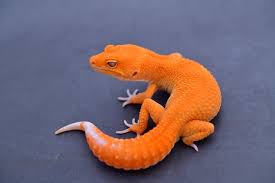GECKO MANDARIN TANGERINE (Eublepharis macularius)
$200.00
Full Description
Here is a complete care guide for the Mandarin Tangerine Leopard Gecko (Eublepharis macularius), a popular and visually striking morph known for its bright orange coloration, often enhanced through line breeding from Tangerine and Mandarin lines.
Mandarin Tangerine Leopard Gecko Care Guide
Morph Overview
| Trait | Description |
|---|---|
| Morph Name | Mandarin Tangerine |
| Scientific Name | Eublepharis macularius |
| Morph Type | Line-bred (Tangerine × Mandarin) |
| Appearance | Bright orange to reddish-orange body; can have carrot tail, reduced pattern, or clean bands |
| Experience Level | Beginner–Intermediate |
Size & Lifespan
| Trait | Value |
|---|---|
| Adult Length | 7–10 inches (18–25 cm) |
| Adult Weight | 50–80 grams |
| Lifespan | 15–20 years (with good care) |
Enclosure Setup
Enclosure Size
-
Juvenile: 10–20 gallons
-
Adult: 20–40 gallon horizontal tank (36″ x 18″ ideal)
Substrate Options
| ✅ Safe | ❌ Unsafe |
|---|---|
| Paper towels | Loose sand |
| Slate or ceramic tile | Calcium sand |
| Reptile carpet | Bark, mulch, or gravel |
| Bioactive (advanced) |
Hides & Decor
Provide at least three hides:
-
Warm Hide – over heating element
-
Cool Hide – for thermoregulation
-
Humid Hide – filled with damp sphagnum moss or eco-earth
Add:
-
Fake or live plants
-
Climbing rocks or branches
-
Flat basking stones
️ Temperature & Humidity
| Area | Temperature |
|---|---|
| Warm side | 88–92°F (31–33°C) |
| Cool side | 75–80°F (24–27°C) |
| Nighttime | 68–72°F (20–22°C) |
| Humidity | 30–40% ambient; 70–80% in humid hide |
Heating
-
Use an under-tank heater (UTH) connected to a thermostat
-
Check surface temps with a digital thermometer probe
-
Optional: Low-wattage basking bulb for daytime warmth (not required)
Lighting
-
UVB optional but beneficial: 5% linear UVB recommended (e.g., Arcadia ShadeDweller)
-
Maintain a 12-hour light/dark cycle
-
Ensure hides are available for light-sensitive individuals
-
Mandarin Tangerines do not have Eclipse traits by default and typically tolerate soft light well
Feeding & Nutrition
Staple Insects
-
Dubia roaches
-
Crickets
-
Mealworms
-
Black soldier fly larvae (BSFL)
Occasional Treats
-
Superworms
-
Waxworms (high fat, use rarely)
Feeding Frequency
| Age | Schedule |
|---|---|
| Juveniles | Daily |
| Adults | Every 2–3 days |
Supplements
| Supplement | Frequency |
|---|---|
| Calcium (no D3) | Always available |
| Calcium + D3 | 1–2× per week |
| Multivitamin | 1× per week |
Always gut-load feeders 24 hours before feeding.
Maintenance
| Task | Frequency |
|---|---|
| Spot clean | Daily |
| Water change | Daily |
| Hide check | Weekly |
| Full clean | Monthly (or as needed) |
For bioactive setups: maintain leaf litter and isopod/springtail populations.
⚠️ Morph-Specific Notes
| Trait | Note |
|---|---|
| Color intensity | Bright orange color may deepen with age and proper diet |
| Line-bred quality | Best color comes from high-quality Mandarin × Tangerine genetics |
| Stress sensitivity | Color may dull during stress or shedding periods |
| No known defects | Unlike Enigma or Lemon Frost, this morph is genetically stable |
Handling Tips
-
Begin gently after a week of acclimation
-
Limit early handling to 5–10 minutes
-
Support all limbs when handling
-
Handle during the evening or night for best temperament
-
Avoid handling during shedding or illness
✅ Summary Checklist
| Element | Recommendation |
|---|---|
| Enclosure | 20–40 gal horizontal tank |
| Heating | UTH + thermostat (88–92°F hotspot) |
| Lighting | Optional UVB, 12-hour light cycle |
| Hides | Warm, cool, and humid |
| Diet | Insects (gut-loaded), calcium, D3 |
| Substrate | Tile, paper towel, or safe bioactive |
| Handling | Calm, short sessions at first |
| Morph safety | Stable with no known defects |

